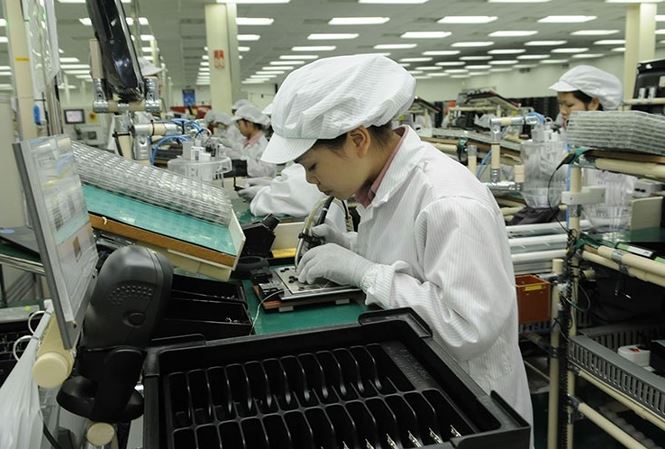Vietnam: Draft strategy on attracting new FDI generation in 2018-2023
The Hanoitimes – The Ministry of Planning and Investment is drafting the foreign direct investment (FDI) strategy for 2018-2023 to fully capitalize on the capital source in the new stage.
With the assistance from the World Bank, the FDI strategy drafts that Vietnam at this stage should focus on sectors having advantages, and those that foreign firms could bring more benefits to, rather than domestic firms.
Under the draft strategy, Vietnam should set out priority sectors for attracting FDI, such as those that needs increased value and competitiveness, including manufacturing (high-grade metals/minerals/chemicals/plastics and high-tech/electronic components); service (logistics and maintenance, repair and overhaul – MRO); agriculture (innovative agricultural products, high value such as rice, coffee, seafood); and travel (high-value tourism services).
Under the draft strategy, Vietnam should set out priority sectors for attracting FDI, such as those that needs increased value and competitiveness, including manufacturing (high-grade metals/minerals/chemicals/plastics and high-tech/electronic components); service (logistics and maintenance, repair and overhaul – MRO); agriculture (innovative agricultural products, high value such as rice, coffee, seafood); and travel (high-value tourism services).
In the short term, priority is to be given to industries with narrow opportunities for competition, such as production (automotive and transport equipment OEMs – Original Equipment Manufacturers and suppliers), and environmental technology (water conservation equipment, solar, wind).
In the medium term, priority should be given to sectors that create and develop skills, including manufacturing (pharmaceuticals and medical equipment), services (education and health services, financial services, financial technology (Fintech), information technology and intellectual services (accounting and design).
The draft also proposed solutions to enhance efficiency in the operation of the Foreign Investment Agency (FIA) under the MPI.
It recommended that Vietnam should remove entry-barriers and maximize the impact of incentives in attracting investments.
Reforms are also needed to more effectively anchor existing investors and motivate them to expand their activities in Viet Nam.
The nation needs to maximize the absorption potential of local companies by strengthening linkages with global value chains.
Nguyen Mai, chairman of the Vietnam Association of Foreign Invested Enterprises (VAFIE), said that this is one of the important contributions for the orientation of foreign investment in the future.
However, Mai said foreign investment cannot be separated from the socio-economic development strategy being carried out throughout the country. At present, Vietnam is implementing the 10-year socio-economic development strategy from 2011-2020. Therefore, the period of the FDI strategy should be adjusted to be appropriate for the 10-year socio economic development strategy, because the period of the FDI strategy for 2018-2023 is too short.
The FDI strategy also needs to address the issue of attracting more investors from the US and the EU, Mai said.
What Vietnam needs to focus on is attracting investment from the US and the EU in the future, but not Japan, South Korea and China. If not resolved, investment in Vietnam will remain based mainly on Asian countries, Mai said.
The strategy should pay attention to promoting more foreign investment in difficult provinces. Although the Government has offered many incentives, few investors have come to the northern mountainous and Central Highland provinces, he said.
Meanwhile, Phan Huu Thang, former director of the FIA, said that the strategy on attracting a new generation of FDI should take into account policies relating to the three special economic zones of Phu Quoc, Van Don and Bac Van Phong, because the final development plan of three zones will be approved next year.
In the medium term, priority should be given to sectors that create and develop skills, including manufacturing (pharmaceuticals and medical equipment), services (education and health services, financial services, financial technology (Fintech), information technology and intellectual services (accounting and design).
The draft also proposed solutions to enhance efficiency in the operation of the Foreign Investment Agency (FIA) under the MPI.
It recommended that Vietnam should remove entry-barriers and maximize the impact of incentives in attracting investments.
Reforms are also needed to more effectively anchor existing investors and motivate them to expand their activities in Viet Nam.
The nation needs to maximize the absorption potential of local companies by strengthening linkages with global value chains.
Nguyen Mai, chairman of the Vietnam Association of Foreign Invested Enterprises (VAFIE), said that this is one of the important contributions for the orientation of foreign investment in the future.
However, Mai said foreign investment cannot be separated from the socio-economic development strategy being carried out throughout the country. At present, Vietnam is implementing the 10-year socio-economic development strategy from 2011-2020. Therefore, the period of the FDI strategy should be adjusted to be appropriate for the 10-year socio economic development strategy, because the period of the FDI strategy for 2018-2023 is too short.
The FDI strategy also needs to address the issue of attracting more investors from the US and the EU, Mai said.
What Vietnam needs to focus on is attracting investment from the US and the EU in the future, but not Japan, South Korea and China. If not resolved, investment in Vietnam will remain based mainly on Asian countries, Mai said.
The strategy should pay attention to promoting more foreign investment in difficult provinces. Although the Government has offered many incentives, few investors have come to the northern mountainous and Central Highland provinces, he said.
Meanwhile, Phan Huu Thang, former director of the FIA, said that the strategy on attracting a new generation of FDI should take into account policies relating to the three special economic zones of Phu Quoc, Van Don and Bac Van Phong, because the final development plan of three zones will be approved next year.
Source: http://hanoitimes.com.vn/investment/2017/11/81E0BB52/draft-strategy-on-attracting-new-fdi-generation-in-2018-2023/


 Thailand
Thailand




